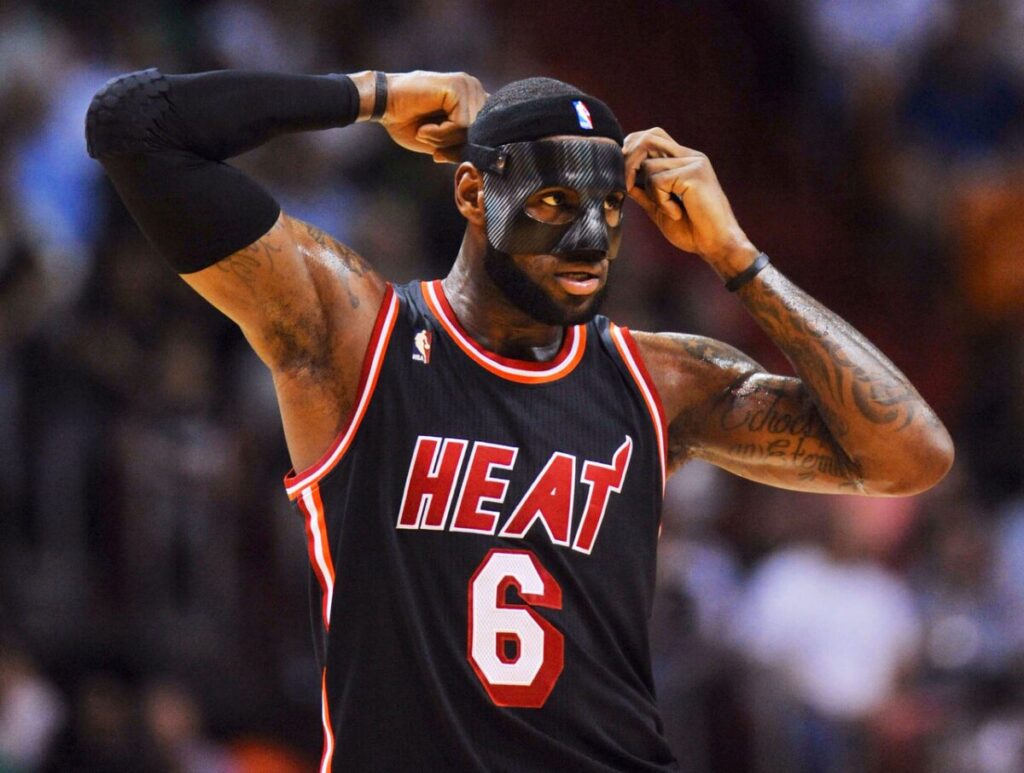In the NBA, players often wear masks and goggles during games.
This practice is not just about style, it’s a crucial safety measure.
Masks serve to shield players from facial injuries. A common injury in basketball is a broken nose. Masks, especially full-face types, are effective in guarding against such injuries.

Goggles are equally important.
They protect players’ eyes. In a contact sport like basketball, eye injuries are a risk.
Goggles help prevent these. NBA players wearing goggles is a common sight.

It’s not just about avoiding injuries, it’s also about vision.
Some players wear prescription lenses in their sports goggles.
The use of protective eyewear in basketball has grown. This change reflects an increased awareness of safety amongst basketball players.
Injuries like broken noses or eye injuries can sideline players.
With protective gear, players reduce these risks.

Wearing masks and goggles is also a sign of solidarity.
It shows support for those who have suffered injuries.
NBA history is filled with examples of players like Wilt Chamberlain, Kareem Abdul-Jabbar, and LeBron James, who have worn protective gear.
Their legacy continues with today’s players.
Why do NBA players wear masks and sports goggles?
It’s about safety, vision, and solidarity. Players wear masks and goggles to protect themselves and honor those who have faced similar challenges.

The History Behind Basketball Players Wearing Sports Goggles
Wilt Chamberlain, an NBA pioneer, first wore a face mask after a broken nose.
This sparked a trend in the league.
NBA players now wear masks for protection and style. Masks guard against facial injuries like broken noses, common in basketball.

A key event was on December 7, 1977, in a Lakers-Rockets game.
Rudy Tomjanovich suffered severe facial injuries, including a broken nose and jaw, from Kermit Washington’s punch.
He returned to play in five months, wearing a protective mask. This incident highlighted the mask’s importance in the NBA, especially for players recovering from injuries.
Tomjanovich’s comeback, aided by the mask, set a precedent.
It showed how masks help players return from injuries and continue their careers. His post-injury All-Star selection further illustrates this point.
Masks in the NBA symbolize not just safety but resilience, which should be enough to answer the question – why do NBA players wear masks?
Do Basketball Players Wear Glasses in NBA Games?

In the NBA, wearing protective eyewear like glasses and goggles while playing basketball is crucial for players prone to eye injuries or those with vision problems.
This practice, while not widespread, is essential in a contact sport like basketball.
The use of safety glasses and goggles helps players avoid eye injuries and continue playing, even after incidents that could impair their vision.
Some players opt for prescription lenses in their goggles, while others wear them as a precaution against potential injuries.
Notable NBA Players Who Wore Glasses and Sports Goggles:
– Wilt Chamberlain: Pioneered the use of protective eyewear in the NBA.
– Kareem Abdul-Jabbar: Wore goggles after corneal abrasions, becoming a symbol for eye safety in basketball.
– Horace Grant: Known for his goggles, worn due to legal blindness and continued post-corrective surgery.
– LeBron James: Briefly experimented with glasses in a game, illustrating the challenges of wearing them in play.
– James Worthy: Adopted glasses following an eye injury, integrating them into his game gear.
– Hakeem Olajuwon: Wore glasses temporarily after an eye injury.
– Kurt Rambis: Wore glasses for severe nearsightedness, becoming a recognizable figure in the NBA.
– Amare Stoudemire: Turned to glasses after a torn iris and detached retina, post-LASIK surgery.
– Wendell Carter Jr.: Began wearing protective glasses in 2021 following an eye injury.
– Reggie Jackson: Continued wearing protective eyewear for comfort and safety after recovering from an eye injury.
LeBron really put on Wendell Carter Jr.'s goggles after this play 😂🥽 pic.twitter.com/hpUz6XlLh3
— Bleacher Report (@BleacherReport) December 13, 2021
While not all basketball players wear glasses or sports goggles, those who do, highlight the importance of protective eyewear in the NBA.
Whether it’s for vision correction or as a safeguard against eye injuries, glasses, and goggles play a vital role in ensuring player safety and performance on the court.
This aspect of NBA gear, though less common than face masks, remains a significant part of the league’s history and player health management.
Why Were Black Masks Banned by the NBA?
The NBA’s stance on black masks worn by players whilst playing basketball has sparked curiosity and speculation.
While there’s no official ban, the league’s actions suggest a preference against them. The reasons behind this are not entirely clear, but several theories exist:
– Visibility Concerns: It’s thought that black masks might hinder a player’s visibility on the court.
– Eye Contact: Allowing other players to see one’s eyes could be crucial for game dynamics, and black masks might obstruct this.
– Aesthetic Reasons: The appearance of black face masks might not align with the NBA’s desired image.
LeBron James‘ case is particularly notable.
The NBA requested him to change his black mask, leading to speculation about the decision’s intent.
Was it a targeted move against LeBron as an NBA player, or part of a broader, unwritten rule?
This incident has fueled debates about whether the NBA’s approach to black masks is a matter of safety, aesthetics, or something more individualized.






